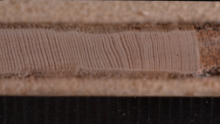You are here
Tree Ring Lab Identifies Champion Elder

This summer, at a forest dominated by Eastern Hemlock in northwestern Pennsylvania, Harvard Forest’s Tree Ring Lab team, led by Neil Pederson and David Orwig, confirmed the oldest-known Eastern Hemlock to date. This tree, discovered by team field scout Erik Danielson, turns out to be at least 651 years old.
With over 3,000 Hemlocks cored over the past 50 years, Eastern Hemlock (Tsuga canadensis) is likely the most cored tree species in Eastern North America. Based on available data, this Hemlock surpasses the previous elder, which was identified in the late 1970’s (in the very same forest!). This new discovery adds nearly 100 years (and nearly 20%) to the maximum known age for the most-cored tree species, indicating that there is much basic natural history to learn about our forests.
While most trees are cored at the 1-meter mark, this individual had hollowed out at the base, requiring researchers to take a sample at 2 meters in height. Based on research led by Dave Orwig, we know Eastern Hemlock can often show evidence of adding 35-80+ years of age when under 1 m tall. This suggests that this individual could easily be 700 to 800 years of age at the root collar!
The team’s plot-level sampling of this stand revealed multiple Eastern Hemlocks that are over 400 years, including around half a dozen that are in between 480 and 535 years in age. This new discovery further confirms that this forest is truly the current epicenter of longevity for Eastern Hemlock to date in eastern North America.
Harvard Forest’s Tree Ring Lab has sampled nearly 100 Eastern Hemlock individuals in this forest, with many samples yet to process. The lab analyses will be exciting as we peer further back in time on the long-term development of this old Eastern Hemlock forest.
Learn more about the Tree Ring Lab's work this past summer by checking out this article in the Post Standard.
Above, Dave Orwig (left) and Laura Smith (right) conduct research at the old growth Eastern Hemlock forest. Below, a photograph of the tree's sample, or "core," shows tick marks for each year of growth. A zoomed in version of this image is shown above. (Photos courtesy of Neil Pederson)
![]()


